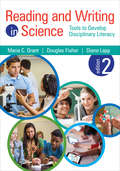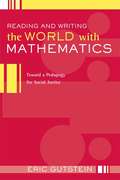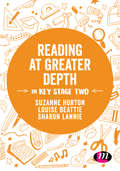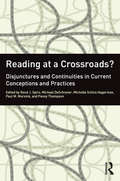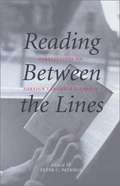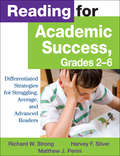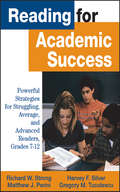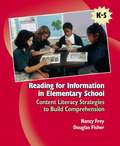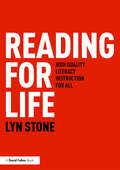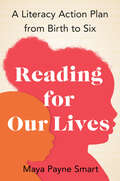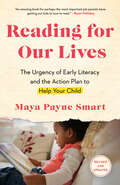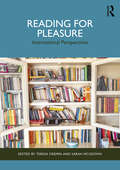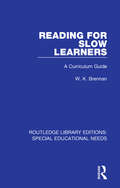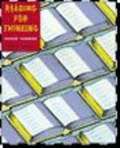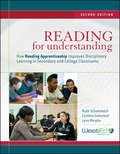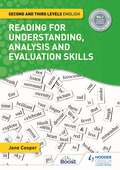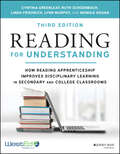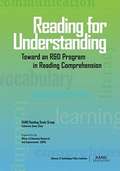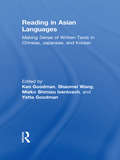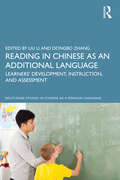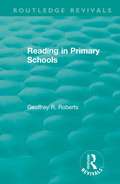- Table View
- List View
Reading and Writing in Science: Tools to Develop Disciplinary Literacy
by Douglas Fisher Maria C. Grant Diane K. LappEngage your students in scientific thinking across disciplines! Did you know that scientists spend more than half of their time reading and writing? Students who are science literate can analyze, present, and defend data – both orally and in writing. The updated edition of this bestseller offers strategies to link the new science standards with literacy expectations and specific ideas you can put to work right away. Features include: A discussion of how to use science to develop essential 21st century skills Instructional routines that help students become better writers Useful strategies for using complex scientific texts in the classroom Tools to monitor student progress through formative assessment When students are curious, they thrive. Give your students the strong base they need to create and share scientific ideas that have an impact in the classroom and beyond. "This is a teacher-friendly book that drew me in from the introduction to the end. Through real-life scenarios combined with useful methods for instruction, it illustrates how science teachers can use language as a tool for teaching science." -Trina Allen, Science Content Specialist Measurement Incorporated "An eminently readable guide for the novice and experienced teacher. The many practical ideas in this volume demonstrate that improving students’ skills in reading and writing can also improve their understanding and ability in science." - Cary Sneider, Associate Research Professor Portland State University, Portland, OR
Reading and Writing in Science: Tools to Develop Disciplinary Literacy
by Douglas Fisher Maria C. Grant Diane K. LappEngage your students in scientific thinking across disciplines! Did you know that scientists spend more than half of their time reading and writing? Students who are science literate can analyze, present, and defend data – both orally and in writing. The updated edition of this bestseller offers strategies to link the new science standards with literacy expectations and specific ideas you can put to work right away. Features include: A discussion of how to use science to develop essential 21st century skills Instructional routines that help students become better writers Useful strategies for using complex scientific texts in the classroom Tools to monitor student progress through formative assessment When students are curious, they thrive. Give your students the strong base they need to create and share scientific ideas that have an impact in the classroom and beyond. "This is a teacher-friendly book that drew me in from the introduction to the end. Through real-life scenarios combined with useful methods for instruction, it illustrates how science teachers can use language as a tool for teaching science." -Trina Allen, Science Content Specialist Measurement Incorporated "An eminently readable guide for the novice and experienced teacher. The many practical ideas in this volume demonstrate that improving students’ skills in reading and writing can also improve their understanding and ability in science." - Cary Sneider, Associate Research Professor Portland State University, Portland, OR
Reading and Writing the World with Mathematics: Toward a Pedagogy for Social Justice (Critical Social Thought)
by Eric GutsteinMathematics education in the United States can reproduce social inequalities whether schools use either "basic-skills" curricula to prepare mainly low-income students of color for low-skilled service jobs or "standards-based" curricula to ready students for knowledge-intensive positions. And working for fundamental social change and rectifying injustice are rarely included in any mathematics curriculum. <P><P>Reading and Writing the World with Mathematics argues that mathematics education should prepare students to investigate and critique injustice, and to challenge, in words and actions, oppressive structures and acts. Based on teacher-research, the book provides a theoretical framework and practical examples for how mathematics educators can connect schooling to a larger sociopolitical context and concretely teach mathematics for social justice.
Reading at Greater Depth in Key Stage 2
by Ms Suzanne Horton Louise Beattie Sharon LannieExpectations in primary English are high, particularly in reading. There is an emphasis on inference and deduction together with vocabulary development: two key elements for preparing pupils to access texts at a higher level. At the same time, there is also a change in the rhetoric around guided reading with teachers trying different pedagogies in order to fully prepare pupils for the demands of the reading curriculum. This book explores the various approaches to developing higher level readers.
Reading at Greater Depth in Key Stage 2 (Exploring the Primary Curriculum)
by Suzanne Horton Louise Beattie Sharon LannieExpectations in primary English are high, particularly in reading. There is an emphasis on inference and deduction together with vocabulary development: two key elements for preparing pupils to access texts at a higher level. At the same time, there is also a change in the rhetoric around guided reading with teachers trying different pedagogies in order to fully prepare pupils for the demands of the reading curriculum. This book explores the various approaches to developing higher level readers.
Reading at a Crossroads?: Disjunctures and Continuities in Current Conceptions and Practices
by Penny Thompson Rand J. Spiro Michael DeSchryver Michelle Schira Hagerman Paul M. MorsinkThe Internet is transforming the experience of reading and learning-through-reading. Is this transformation effecting a radical change in reading processes as readers synthesize understandings from fragments across multiple texts? Or, conversely, is the Internet merely a new place to use the same reading skills and processes developed through experience with traditional print-based media? Are the changes in reading processes a matter of degree, or are they fundamentally new? And if so, how must reading theory, research, and instruction adjust? This volume brings together distinguished experts from the fields of reading research, teacher education, educational psychology, cognitive science, rhetoric and composition, digital humanities, and educational technology to address these questions. Every question is not answered in every chapter. How could they be? But every contributor has many thoughtful things to say about a subset of these important questions. Together, they add up to a comprehensive response to the issues the field faces as it approaches what may well be—or not —a crossroads. A website devoted to extending discussion around the book in creative (and disjunctive) ways [readingatacrossroads.net] moves it beyond the printed page.
Reading between the Lines: Perspectives on Foreign Language Literacy
by Peter Charles PatrikisThis book presents a collection of new and stimulating approaches to reading in a foreign language. The contributors to the volume all place reading at the heart of learning a foreign language and entering a foreign culture, and they consider issues and methods of language education from such diverse perspectives as cognitive theory, applied linguistics, technology as hermeneutic, history, literary, theory, and cross-cultural analysis. The contributors--teachers of French, German, Greek, Japanese, and Spanish--call for language teachers and theorists to refocus on the importance of reading skills. Emphasizing the process of reading as analyzing and understanding another culture, they document various practical methods, including the use of computer technology for enhancing language learning and fostering cross-cultural understanding.
Reading for Academic Success, Grades 2-6: Differentiated Strategies for Struggling, Average, and Advanced Readers
by Harvey F. Silver Richard W. Strong Matthew J. PeriniExamines seven critical areas that can develop average or struggling readers into thoughtful, high-achieving A+ readers who can comprehend, analyze, and summarize different kinds of texts.
Reading for Academic Success: Powerful Strategies for Struggling, Average, and Advanced Readers, Grades 7-12
by Harvey F. Silver Richard W. Strong Matthew J. Perini Gregory M. TuculescuThrough specific examples, real-life scenarios, and diagrams, this book vividly conveys the most fundamental and effective tactics for boosting reading proficiency while enhancing student and teacher performance.
Reading for Christian Schools 5
by Bju StaffA book that helps students build their reading and thinking skills by use of literature materials provided.
Reading for Information in Elementary School: Content Literacy Strategies to Build Comprehension
by Douglas Fisher Nancy FreyReading for Information in Elementary School: Content Literacy Strategies to Build Comprehension was written to give k-5 teachers the tools they need to lay an educational groundwork that promotes students’ success with informational text from the early grades. Packed with research-based, classroom-proven strategies, the book follows a before, during, and after reading format that models the most effective approach to reading for information, focusing on the processes required to develop content literacy. You’ll meet the teachers, sit in on their lessons, witness their students’ responses, and come away from this book with a model for teaching your students to read successfully for information and a handbook of proven strategies to implement.
Reading for Life: High Quality Literacy Instruction for All
by Lyn StoneWhy is it that more people can’t read and write? Why are there still so many vastly different methods of teaching literacy? Why do people still argue about it? <P><P>Reading for Life examines these three questions, addressing the less evidence supported ideas about teaching reading and writing which are still alive and well in schools all over the world. This accessible guide bridges the gap between research and practice, translating academic findings into practical suggestions and ready-to-use techniques. <P><P>Written in an approachable style and with informative graphics, vignettes and interviews woven throughout, this book covers: <li>the components of literacy, including phonics, vocabulary and fluency <li>the history of approaches to literacy teaching and an overview of the key figures <li>government-level inquiries into the provision of reading and writing teaching <li>the mindset which leads to acceptance of poor practice <li>the essential components of an effective literacy program with practical advice on selecting resources to get the job done well <P><P>Reading for Life helps educational practitioners make informed decisions about which teaching methods to reject and select, and empowers parents to ask the right questions of professionals and policy makers. This book is a timely exploration of poor teaching methods and is an innovative, fresh assessment of how high quality literacy teaching can be provided for all.
Reading for Our Lives: A Literacy Action Plan from Birth to Six
by Maya Payne SmartAn award-winning journalist and literacy advocate provides a clear, step-by-step guide to helping your child thrive as a reader and a learner.When her child went off to school, Maya Smart was shocked to discover that a good education in America is a long shot, in ways that few parents fully appreciate. Our current approach to literacy offers too little, too late, and attempting to play catch-up when our kids get to kindergarten can no longer be our default strategy. We have to start at the top. The brain architecture for reading develops rapidly during infancy, and early language experiences are critical to building it. That means parents&’ work as children&’s first teachers begins from day one too—and we need deeper knowledge to play our positions.Reading for Our Lives challenges the bath-book-bed mantra and the idea that reading aloud to our kids is enough to ensure school readiness. Instead, it gives parents easy, immediate, and accessible ways to nurture language and literacy development from the start. Through personal stories, historical accounts, scholarly research, and practical tips, this book presents the life-and-death urgency of literacy, investigates inequity in reading achievement, and illuminates a path to a true, transformative education for all.
Reading for Our Lives: The Urgency of Early Literacy and the Action Plan to Help Your Child
by Maya Payne SmartCompletely revised and updated! Now in paperback. An award-winning journalist and literacy advocate provides a clear, step-by-step guide to helping your child thrive as a reader and a learnerToday&’s children face intense pressure to meet rising academic standards and prepare for future careers, but most fall dangerously short. Early struggles with language and literacy often snowball into lasting disadvantages. Millions of U.S. kids don&’t learn to read well in elementary school, driving low adult literacy rates and threatening the nation&’s economic productivity, public health, and social equity.In Reading for Our Lives, journalist Maya Payne Smart shows that the literacy crisis starts at home. Too many parents expect schools to unlock their child&’s reading potential, unaware that even the best classroom instruction (which most don&’t get) can&’t make up for weak early preparation or inconsistent support outside of school. Smart breaks down the latest research to show parents how to do their part to build essential literacy skills. She busts the myth that bedtime stories are parents&’ greatest contribution to kids&’ reading development. She advocates instead for weaving a range of simple, fun, free literacy habits and activities into everyday family life—and shows you how to do it.With optimism and evidence, Reading for Our Lives delivers a clear call to action and a path forward for families, schools, and communities to beat the literacy crisis together.
Reading for Pleasure: International Perspectives
by Teresa Cremin Sarah McGeownGrowing evidence of the vital role reading for pleasure plays in children and young people’s academic outcomes and socio-emotional wellbeing has placed it high on the agenda in both educational policy and practice.This valuable collection draws upon a range of disciplinary perspectives and methodological approaches, to explore how reading for pleasure is experienced and enacted, and highlights the implications and benefits of such volitional reading in the lives and learning of children and young people. It offers contributions from leading international researchers on current evidence and literature within the field, identifying the causes and consequences of reading for pleasure, and framing this within the context of understanding readers and applying this to developing effective pedagogical practices. With chapters examining how we may shape the reading experience, this book is divided into four sections: Understanding readers, including factors such as motivation, gender and identity The nature of texts, including fiction, sensory and digital texts Pedagogies and practices, exploring agency, book talk and reading aloud Environments conducive to reading for pleasure, including homes, school libraries, classrooms and communities Presenting diverse and interdisciplinary perspectives, this will be a key text for researchers, teacher educators and policy-makers who wish to become better informed in their thinking, discourse and practice when supporting children and young people in learning to read for pleasure.
Reading for Slow Learners: A Curriculum Guide (Routledge Library Editions: Special Educational Needs #5)
by W. K. BrennanFirst published in 1978. Reading for Slow Learners is a practical guide for teachers, defining the objectives of the reading curriculum, identifying important aspects of teaching method and suggesting various approaches. This title will also be of interest to parents of children with learning difficulties.
Reading for Thinking (4th edition)
by Laraine E. Flemming Ann Marie RadaskiewiczThis book takes a structured approach to the teaching of academic reading skills. Section by section, the book builds on skills such as reading comprehension, summarizing, disseminating, argument analysis, and short essay writing. Each section includes readings to illustrate concepts, and these same concepts are tested with several exercises at the end of each section in the book.
Reading for Understanding
by Ruth Schoenbach Cynthia Greenleaf Lynn Murphy"As elegantly practical as it is theoretically elegant. It is a guided tour, as one examines the tools of expert teachers as they engage students in a journey that is aptly dubbed Reading Apprenticeship?learning how to become a savvy, strategic reader under the tutelage of thoughtful, caring, and demanding teachers.? P. David Pearson, University of California, Berkeley, and founding editor of the Handbook of Reading Research. Reading for Understanding is a monumental achievement. It was a monumental achievement when it came out as a first edition in 1999, bringing years of rigorous reading research together in a framework for teaching that made sense in actual secondary school classrooms. Now, just thirteen years later, Schoenbach and Greenleaf have several randomized clinical trials and multiple on-going studies at their fingertips to demonstrate the effects of this approach for developing the reading and thinking of young people in our nation?s middle and high school classrooms, as well as in community college classrooms. Their careful work on developing disciplinary literacy among all students represents a passion for and commitment to supporting students?and their teachers?in reading for understanding, which translates to reading for enjoyment, self-awareness, learning, and for purposeful and informed action in our society. ?Elizabeth Moje, Arthur F. Thurnau Professor and Associate Dean for Research, School of Education, University of Michigan Reading Apprenticeship has proven to be an inspiration to Renton Technical College faculty and students alike. They have learned together to view themselves as readers in transformative ways, as they embrace powerful techniques to increase reading comprehension. The ideas and strategies in Reading for Understanding anchor this new and broad-based energy around reading and an enthusiasm among our faculty to model effective reading strategies for our students. ?Steve Hanson, President, Renton Technical College, Renton, Washington Reading for Understanding has the finest blend I have seen of research, strategies, and classroom vignettes to deepen teacher learning and help them connect the dots between theory and practice. ?Curtis Refior, Content Area Literacy Coach, Fowlerville Community Schools, Fowlerville, Michigan A teacher-tested, research-based resource for dramatically improving reading skills Published in partnership with WestEd, this significantly updated second edition of the bestselling book contains strategies for helping students in middle school through community college gain the reading independence to master subject area textbooks and other material. Based on the Reading Apprenticeship program, which three rigorous "gold standard" research studies have shown to be effective in raising students' reading achievement Presents a clear framework for improving the reading and subject area learning of all students, including English learners, students with special needs, as well as those in honors and AP courses Provides concrete tools for classroom use and examples from a range of classrooms Presents a clear how-to for teachers implementing the subject area literacies of the Common Core Standards Reading for Understanding proves it's never too late for teachers and students to work together to boost literacy, engagement, and achievement.
Reading for Understanding, Analysis and Evaluation Skills: Second And Third Levels English
by Jane CooperSyllabus: CfE (Curriculum for Excellence, from Education Scotland) and SQALevel: BGE S1-3: Third & Fourth LevelsSubject: EnglishCapture pupils' imagination and attention with a rich collection of quality texts, handpicked by Jane Cooper to ensure that pupils want to start reading - and keep reading.Tailored to the interests, motivations and abilities of pupils working towards Second and Third Levels in S1 to S3, this book will help you to close the attainment gap.> Unlock a world of meaning, connection and questioning. Part One teaches the close reading skills that pupils need throughout their lives, with simple explanations, lots of examples and tasks set at three levels - 'Building', 'Strengthening' and 'Extending'.> Apply and develop RUAE skills and monitor progress. Part Two contains ten practice assessments that gradually increase in difficulty, with longer passages, more complex language and more challenging questions.> Save time sourcing non-fiction text extracts. Drawing on her long career as an English teacher and author, Jane Cooper has a talent for knowing which topics pupils will find curious or fun - from the world's cheesiest pizza to a mysterious metal column that appeared in a desert.> Build the foundations for success in National qualifications. With Course Reports showing that N5 and Higher students most commonly lose marks in the RUAE papers, this book offers a proactive solution to building confidence and skills during BGE.> Support the individual needs of every pupil. Providing differentiated, age-appropriate content and tasks, this is the perfect resource for mixed-ability classrooms - especially when used alongside its companion volume, Levels 3-4 English: Reading for Understanding, Analysis and Evaluation Skills.
Reading for Understanding, Analysis and Evaluation Skills: Second And Third Levels English
by Jane CooperSyllabus: CfE (Curriculum for Excellence, from Education Scotland) and SQALevel: BGE S1-3: Third & Fourth LevelsSubject: EnglishCapture pupils' imagination and attention with a rich collection of quality texts, handpicked by Jane Cooper to ensure that pupils want to start reading - and keep reading.Tailored to the interests, motivations and abilities of pupils working towards Second and Third Levels in S1 to S3, this book will help you to close the attainment gap.> Unlock a world of meaning, connection and questioning. Part One teaches the close reading skills that pupils need throughout their lives, with simple explanations, lots of examples and tasks set at three levels - 'Building', 'Strengthening' and 'Extending'.> Apply and develop RUAE skills and monitor progress. Part Two contains ten practice assessments that gradually increase in difficulty, with longer passages, more complex language and more challenging questions.> Save time sourcing non-fiction text extracts. Drawing on her long career as an English teacher and author, Jane Cooper has a talent for knowing which topics pupils will find curious or fun - from the world's cheesiest pizza to a mysterious metal column that appeared in a desert.> Build the foundations for success in National qualifications. With Course Reports showing that N5 and Higher students most commonly lose marks in the RUAE papers, this book offers a proactive solution to building confidence and skills during BGE.> Support the individual needs of every pupil. Providing differentiated, age-appropriate content and tasks, this is the perfect resource for mixed-ability classrooms - especially when used alongside its companion volume, Levels 3-4 English: Reading for Understanding, Analysis and Evaluation Skills.
Reading for Understanding: How Reading Apprenticeship Improves Disciplinary Learning in Secondary and College Classrooms
by Ruth Schoenbach Cynthia Greenleaf Lynn Murphy Linda Friedrich Nika HoganImprove student outcomes in reading and literacy with the latest edition of this bestselling text The newly revised Third Edition of Reading for Understanding: How Reading Apprenticeship Improves Disciplinary Learning in Secondary and College Classrooms is the latest iteration of the best-selling, landmark book in the field of adolescent literacy. The book contains strategies for boosting the reading independence of middle, secondary, and college students. Research conducted by NSF, IES, and OIIhas validated the model taught in Reading for Understanding, demonstrating its effectiveness in raising students’ reading achievement levels. The authors teach a clear and concise instructional framework for students at all learning levels, from those with special learning needs to those taking honors and Advanced Placement courses. The book also includes: A direct correlation to disciplinary literacy, making the book an even more valuable resource in a wide range of classrooms Explanation of the social and personal dimensions for building a foundation for engaged learning Discussions of the value of setting aside dedicated class time for independent, silent readingWith collaboration tips that go beyond the classroom and advice on building a cognitive “reading toolbox,” Reading for Understanding is an indispensable resource for teachers at the Grade 6 and up, literacy coaches, reading teachers, community college instructors, and other school leaders.
Reading for Understanding: Toward an R & D Program in Reading Comprehension
by Catherine SnowIn fall 1999, the Department of Education's Office of Educational Research and Improvement (OERI) asked RAND to examine how OERI might improve the quality and relevance of the education research it funds. The RAND Reading Study Group (RRSG) was charged with developing a research framework toaddress the most pressing issues in literacy. RRSG focused on reading comprehension wherein the highest priorities for research are: (1)Instruction <How can we best promote the development of proficient reading and prevent reading comprehension difficulties? (2) Teacher preparation andprofessional development <How can we prepare teachers to deliver effectivecomprehension instruction? (3) Assessment <How can we develop an assessment system for reading comprehension that includes the design of valid and reliable measures of self-regulated, strategic reading that are sensitive toinstructional interventions? RRSG concluded that the research infrastructure must: (a) obtain long-term funding that is sustained across administrations and political constituencies; (b) acquire intellectual leadership that endures over a substantial time frame and is insulated from political forces; (c) synthesize knowledge across the various research initiatives in systematic ways; (d) enlist a cadre of well-trained investigators; and, (e)fund research that is rigorous and of high quality.
Reading in Asian Languages: Making Sense of Written Texts in Chinese, Japanese, and Korean
by Yetta Goodman Ken Goodman Shaomei Wang Mieko Shimizu IventoschReading in Asian Languages is rich with information about how literacy works in the non-alphabetic writing systems (Chinese, Japanese, Korean) used by hundreds of millions of people and refutes the common Western belief that such systems are hard to learn or to use. The contributors share a comprehensive view of reading as construction of meaning which they show is fully applicable to character-based reading. The book explains how and why non-alphabetic writing works well for its users; provides explanations for why it is no more difficult for children to learn than are alphabetic writing systems where they are used; and demonstrates in a number of ways that there is a single process of making sense of written language regardless of the orthography. Unique in its perspective and offering practical theory-based methodology for the teaching of literacy in Chinese, Japanese, and Korean to first and second language learners, it is a useful resource for teachers of increasingly popular courses in these languages in North America as well as for teachers and researchers in Asia. It will stimulate innovation in both research and instruction.
Reading in Chinese as an Additional Language: Learners’ Development, Instruction, and Assessment (Routledge Studies in Chinese as a Foreign Language)
by Dongbo Zhang Liu LiReading in Chinese as an Additional Language focuses on Chinese literacy acquisition, which has been considered most difficult by both learners and teachers of Chinese as an additional language (CAL). Three major areas are covered: (1) acquisition of Chinese characters; (2) reading comprehension subskills and reader’s identity; (3) reading instruction and assessment. The first part delves into the foundation of Chinese literacy development—how to learn and teach Chinese characters. The second part examines various learners’ reading comprehension subskills, as well as the evolution of learners’ literacy identity. The third part explores effective instructional methods and assessment practices for CAL reading development. Theoretically, this book provides frameworks and evidence from both cognitive and sociocultural perspectives on the nature of CAL reading development. Pedagogically, the book showcases how to teach and assess CAL reading skills. Methodologically, this book includes empirical studies using both qualitative and quantitative methods. In terms of scope, the book covers a much broader spectrum of issues about CAL reading research and classroom teaching than has previously been available. Writing is also discussed in several chapters. In terms of technology, the book includes discussion on how the use of computers, the Internet, and social media impacts students’ Chinese literacy acquisition. This book will help CAL researchers and educators better understand the nature of CAL reading development and become well informed about CAL classroom teaching and assessment, including the application of interactive approaches to teaching and assessing diverse reading skills.
Reading in Primary Schools (Routledge Revivals)
by Geoffrey R. RobertsLearning to read and the teaching of reading have long been surrounded with controversy. Originally published in 1969, this book takes the view that the subject is best approached via linguistic theory. The relationship between reading and spoken language is clearly brought out in the author’s attempt to define more closely the area in which the teacher has to operate when teaching children to read. His analysis of reading problems in children up to the age of 11 will encourage experienced teachers to question constructively their own beliefs and practices, while the book as a whole provides a valuable introduction to the psychology of reading for the student of education.
